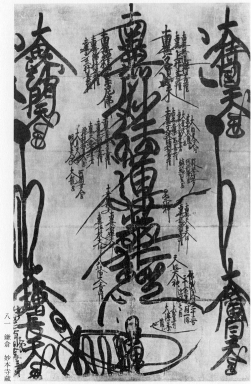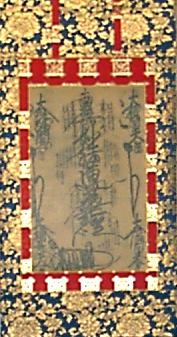In the 15th chapter of the Lotus Sutra, innumerable
bodhisattvas emerge from the sky beneath the Saha-world with
their four leaders: Superior-Practice, Limitless-Practice,
Pure-Practice, and Steadily-Established-Practice. They are the
original disciples of the Original Buddha who are possessed of
the thirty-two physical marks of greatness and are incomparably
greater in stature and power than even the celestial bodhisattvas of the provisional teachings. In chapter 15, Shakyamuni Buddha
does not commission the celestial bodhisattvas who are already
present with the task of spreading the Lotus Sutra in
the Latter Age, and summons these bodhisattvas instead. In
chapter 21 they are given the specific transmission of the Wonderful
Dharma of the Lotus Flower Sutra consisting of the
teachings, the supernatural powers, the treasury, and the
achievements of the Tathagata. Therefore, they are the ones who
are responsible for propagating the Lotus Sutra in the
Latter Age of the Dharma. Anyone who upholds the Odaimoku in
this age is said to be a Bodhisattva of the Earth or, more
humbly, one of their followers.
The Bodhisattvas of the Earth are intimately related to the
Original Buddha, because the eternal presence of the Original
Buddha also means that his original disciples are also present.
In Bodhisattva Archetypes, Taigen Daniel Leighton observes:
"The Lotus Sutra is also known for its
teaching abut the vast extent of Shakyamuni Buddhas lifetime,
that Buddha is always present, intentionally choosing to
appear to pass away or else to reveal himself, whichever is
most beneficial. Thanks to his cosmic omnipresence,
bodhisattvas are also pervasive in time and space. Although
we do not always know of them, when needed they can pop out
of the ground, from the soil of the earth and from the ground
or roots of our own being." (p.33)
Shinjo Suguro, commenting on the 15th chapter of the Lotus
Sutra in his book Introduction to the Lotus Sutra, says of them:
"It is important to note that the Bodhisattvas who
sprang up from beneath the earth, who first appear in this
chapter, are not recognized by anyone in the congregation,
not even by Maitreya, who is destined to be our next Buddha. These great Bodhisattvas appear only in this sutra and not in
any other. Only these Bodhisattvas, who sprang up from
beneath the earth, have the qualifications necessary to
spread the Lotus Sutra in the evil and degenerate World of
Endurance. Later on, in Chapter Twenty-one, 'Supernatural
Powers of the Tathagata,' Shakyamuni will transmit the Lotus
Sutra directly to them.
"Here it is revealed that the Bodhisattvas who
sprang up from beneath the earth are the exemplary
Bodhisattvas of the Lotus Sutra. Many other Bodhisattvas have
appeared before this chapter, but these are the only ones who
fully live up to the Sutra's teachings. Thus they symbolize
the ideal, the models for dynamic activity. Their sphere of
action is summarized in the lines 'They are no more defiled
by worldly desires than a lotus flower is by the water in
which it grows.'" (p. 127)
The Bodhisattvas of the Earth are also the representatives of
the Original Gate of the Lotus Sutra, the latter half of
the sutra which contains the essential teaching. In the first
half of the sutra, the Imprinted Gate, the theoretical teaching
of the One Vehicle is taught. This teaching is called theoretical
because it teaches that "in theory" all people can
become buddhas because all along the Buddha was teaching the One
Vehicle that leads to buddhahood. The provisional bodhisattvas,
like Maitreya Bodhisattva and Accumulated-Wisdom Bodhisattva,
represent this principle by providing a model of gradual
cultivation to attain buddhahood. For them, bodhisattva practice
is the cause of buddhahood which must precede it. The latter half
of the Lotus Sutra, however, is the essential teaching
of the Eternal Shakyamuni Buddha. The essential teaching reveals
that buddhahood has no beginning or end and that the
"cause" of bodhisattva practice is actually
simultaneous with the "effect" of buddhahood in the
eternal enlightenment of Shakyamuni Buddhafs. One enters into this
unity of practice and enlightenment through faith in the living
actuality of buddhahood already present in the figure of the
Eternal Shakyamuni Buddha. This is the teaching of the Original
Buddha, and it is only his original disciples, the Bodhisattvas
of the Earth, who are entrusted to propagate such a teaching
during the critical time of the Latter Age of the Dharma.
The four leaders of the Bodhisattvas of the Earth represent
the four characteristics of Nirvana or Buddhahood as taught in
the Nirvana Sutra: true self, eternity, purity, and bliss.
Namu Jogyo Bosatsu
Visistacaritra Bodhisattva ~ Superior-Practice
This bodhisattva represents the true self which is the
selflessness of Nirvana. Nichiren Shonin is considered by the Nichiren Shu to be the appearance of Bodhisattva
Superior-Practice because he alone fulfilled the role of Bodhisattva Superior-Practice by being the first person to spread the Odaimoku.
Namu Muhengyo Bosatsu
Anantacaritra Bodhisattva ~ Limitless-Practice
This bodhisattva represents eternity which is
the unborn and undying nature of Nirvana.
Namu Jyogyo Bosatsu
Visuddhacaritra Bodhisattva ~ Pure-Practice
This bodhisattva represents purity which is
Nirvana's freedom from all that is impure.
Namu Anryugyo Bosatsu
Supratisthitacaritra Bodhisattva ~
Steadily-Established Practice
This bodhisattva represents bliss which is
Nirvana's liberation from suffering.
|








